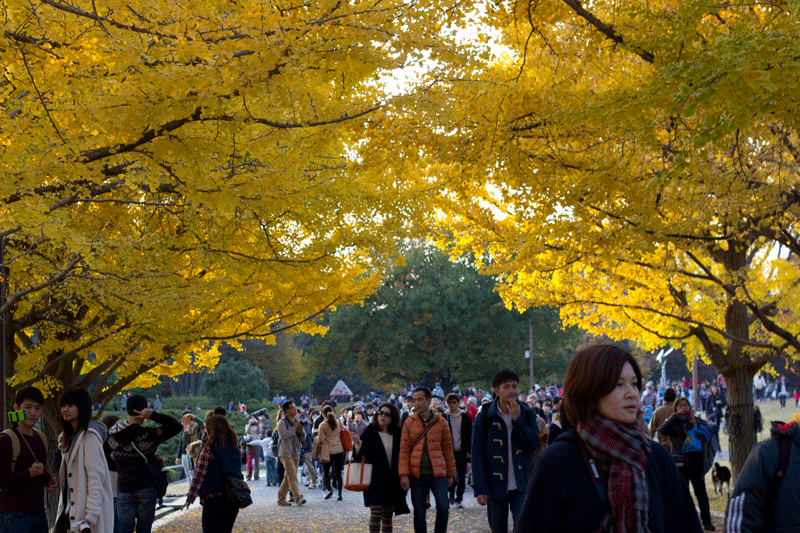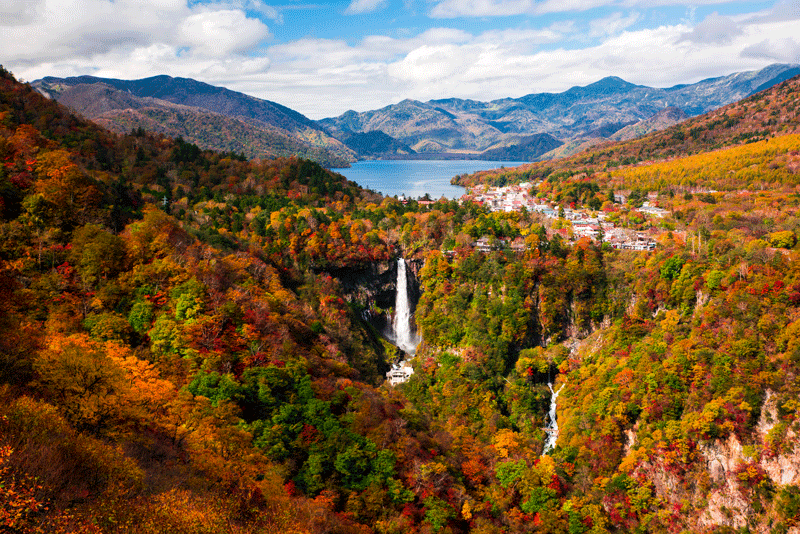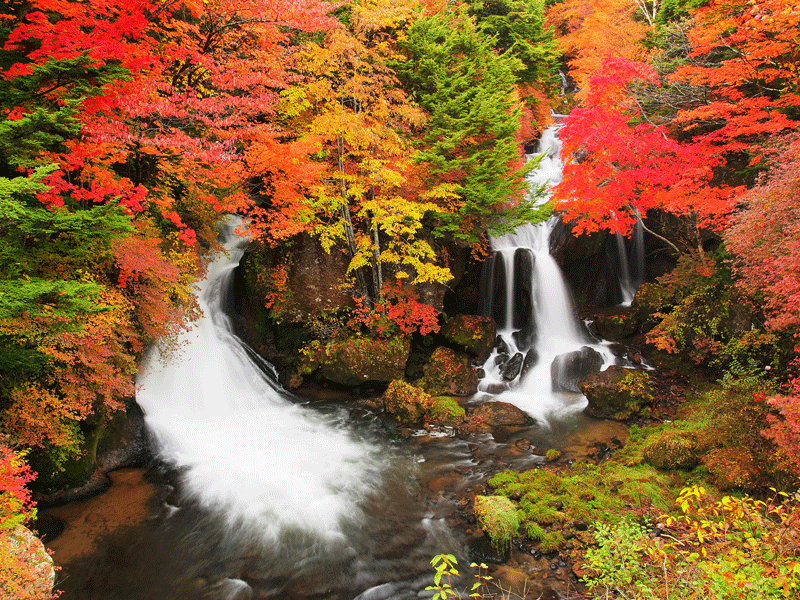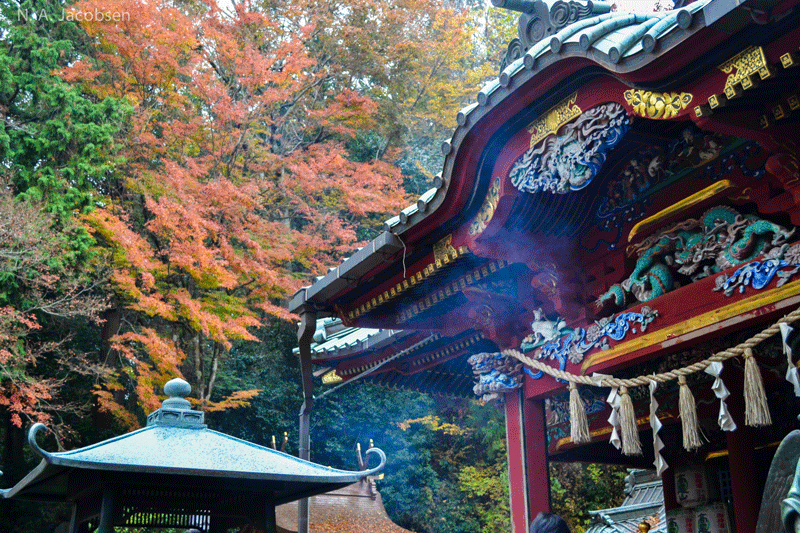Autumn tends to sneak up on Japan, bringing in chilly night breezes and crisp, bright mornings that replace the haze-accented, humid sunrises. While many might still be mourning the loss of their prized summer vacation, the vibrant mosaics suspended on tree branches that fill the parks and line the city streets serve as pleasant recompense.
In Japanese, there are specific terms for the changing hues of autumn, or aki: koyo (leaves changing colors) – a word that happens to share the same kanji (紅葉) as the word momiji (Japanese maple). The act of seeking out places to view the fall foliage is known as “kari.” A seasonal pastime in the “Land of A Thousand Autumns” is to hunt for such locations, whether to take in the fresh air, enjoy the view, escape the city, or nowadays, to snap something decent for their Facebook or Instagram feed. In the lull between Halloween and finding out where to find a turkey for Thanksgiving, perhaps one of these easy day trips in and near to Tokyo will help you paint your autumn a new color.
Nikko
One of the most-visited and renowned locations for koyo is Nikko. The peaceful region is a memorable and special place for Japan – and autumn highlights brings out the best in this Tochigi Prefecture town. Regular buses and shinkansen run up to Nikko several times a day, and the curves of the famed Irohazaka highway that winds through Nikko shouldn’t be missed if you’ve got your own vehicle. These are a few highlights to visit – but you might want to act fast for this region: as of time of writing, the peak of colors may have passed.
Lake Odashiro is a marshland in summer and a lake in fall – a secluded, rare wonder in Japan that draws in numerous hikers and visitors year-round. On fall mornings, a low fog blankets the fields between the hills. Boardwalks wrap around all corners of the marshland. Though there are several waterfalls buried in mountains and shrouded in foliage, including Kegon and Yudaki Falls, Ryuzu Falls in Nikko may take the cake. There is a viewing platform where visitors can make out the shape of a dragon’s head in the falls, and observe the lake under the low-hanging branches. A late-bloomer for the region, Shoyoen Garden sees changing leaves in later November and through December. The expanses of maple trees surround a neat pond, all of which are illuminated in the evenings.
Tanzawa Region
Lake Tanzawa, with its teal green waters, stretches towards a snow-peaked Mount Fuji, surrounded by overhanging branches and embraced by a sloping, sandy bank for visitors to relax on. Nearby mountains, like Furosan and Onoyama, are draped in yellow and red trees, making for breathtaking views in a quiet region. It is a great place for a picnic and a light hike. Nearby are Tenman & Kamioda Shrines; both rest alongside Miho Dam, nestled in a thick forest that turns brilliant colors in fall. The lake and shrines are easily reached from the Yamakita area (less than a two-hour train ride or drive from Tokyo), and just 12 minutes from Yaga Station by car.
Around Tokyo
Northwest of Tokyo, not far from Ome—and a fifteen-minute drive from Mitake Station, are Mount Mitake, Mitake Gorge, and the Ome Forest. Several hiking trails, camping grounds, waterfalls, and picnic spots are conveniently located in the immediate area. A small village next to the mountain has several inns and onsen hotels for weekend stays. There are relaxed routes for those not looking for a challenge, and harder routes for those looking to avoid crowds. Red-roofed temples and softly-trodden paths cover the land all around.
Southwest of Tokyo, along the Odakyu Line, are prominent koyo spots including Odawara and Hakone. Though quite different—Odawara is a rural haven for camping enthusiasts, with beautiful, hidden rivers and almost no trails to speak of other than those you make yourself, and Hakone is an established resort area with museums, hotels, and restaurants for couples and families—both offer locations where you can enjoy autumn to its fullest. Reaching Odawara camping areas (such as Forest Adventure or Ikoi Camp) will require a taxi or a rental car, after arriving by train at Odawara Station (about 30 minutes from Tokyo Station by shinkansen, or a couple of hours on the Odakyu Line from Shinjuku). Hakone is reachable by train (Romancecar, an hour from Shinjuku), and boats are available for rent at nearby Ashinoko.
Tachikawa is an often overlooked destination by Tokyoites who imagine they need to go further to immerse themselves in nature. For those with less time on their hands, Tachikawa’s Showa Kinen Koen is a remarkable gem within the Tokyo Metropolitan area that is a manageable place to visit. With a sprawling field, trails that wind for hours, bikes available to rent, and various plots of land dedicated to seasonal flowers, it’s easy to forget that you’re still “in Tokyo” while there. It’s a family-friendly place with areas for dogs to play in, too. Take the JR Chuo Line from Shinjuku Station, and walk about fifteen minutes from the north exit of Tachikawa Station. 500 Yen for adults to enter.

Tachikawa Showa Kinen Koen (Image courtesy of www.japanexperterna.se)
No list is complete without Mount Takao, which offers all one could want out of fall: leaves thickly layering the hiking trails, wide panoramas that include Tokyo and Yokohama, rolling hills coated in colorful forests, decorated temples, wildlife, and refreshments at lookout spots at the summit. Returning visitors are familiar with the eight different routes to the top, and the three different ways up: walking, cable car, or lift. This is one of the few public places that allow night hiking as well if that’s an adventure you’re willing to try. Nearby ryokan are available for lengthier stays. The JR and Keio Lines go out to Takao Station from downtown; the mountain is a short walk or bus ride from the train stations.
Inside Tokyo, Shinjuku Gyoen, Mukojima Hyakka-en (Sumida), Koshikawa Koraku-en (Bunkyo), Rikugi-en Koen (Bunkyo), and Tonogayato Park all sport nicely trimmed, well-kept areas for people to meander in during an afternoon. All have on-site cafes, and a few of them have entrance fees and parking available. Rikugi-en Koen may be especially interesting for photographers looking for a decent place to shoot parks at night: there is a glassy, still pond that reflects symmetrical views of illuminated trees after dusk. Most of the parks start showing changes in color from mid-to-late November and through December and are accessible from major train lines around Tokyo.
Straddling both Meguro and Setagaya wards surrounded by neighborhoods, Komazawa Olympic Park is situated a couple minutes’ walk from Komazawa Station. The park still stands, with relatively the same layout it had during the Tokyo 1964 Olympics. During the fall, the running paths and outdoor courts erupt in gold, orange, and red, attracting athletes and park-goers from all over Tokyo. Bring a pair of rackets, good set of shoes, bike, or a furry friend with you to the park – it’s open 24 hours and free to the public, while the old Olympic Stadium and pagoda make for a great source of motivation and a scenic backdrop, respectively, amongst the foliage. A number of sports events and festivals take place frequently on the weekends, so choose your day of exploration accordingly.
Kamakura, a hit Japanese beach destination for all demographics during the summer, is perhaps one of the more surprising places to find koyo. Steer a bit from the beach and the nearby hills and temples will quickly isolate you from the city and take you into the heart of autumn, even within the bamboo forests. Most people will flock to the Daibutsu, but we recommend heading up a nearby staircase to Hasedera, a temple with much more rewarding views. Make a day of it and explore Kita-Kamakura as well, where some of Japan’s tallest pine trees protect the area’s flowered cemeteries. Numerous buses will lead to various trails and hills in the vicinity. Pack snacks and water as there are fewer establishments and vending machines on the way.
Nikko photos (Main and Ryuzu Falls) provided by Rakuten Travel.










